In Greek mythology, nymphs are divine spirits of nature that played integral roles in the stories, landscapes, and deities of ancient Greece. The term “nymph” translates to “young girl” in Greek, and these ethereal beings were often depicted as beautiful young women who embodied the essence of nature.
Nymphs can be categorized into various types, including Dryads, Naiads, and Oreads, each representing different aspects of the natural world. These nymphs were not merely mythical creatures but symbolic representations of the connection between humans and the environment.
Key Takeaways:
- Nymphs are divine spirits of nature in Greek mythology.
- They were often depicted as young women and embodied the essence of the natural world.
- Nymphs can be categorized into different types, such as Dryads, Naiads, and Oreads.
- They symbolize the connection between humans and nature, highlighting the importance of preserving and appreciating the environment.
- Nymphs played significant roles in Greek mythology and were associated with various gods and goddesses.
The Nymphs: The Dryad, Naiad, and Oread
In Greek mythology, nymphs play a significant role as divine spirits of nature. These beautiful, ethereal beings are closely associated with different natural elements and were an integral part of ancient Greek culture. There are various types of nymphs, each with their own unique characteristics and domains.
Dryads: Tree Nymphs
Dryads are nymphs who reside in specific types of trees, such as oaks, pines, and ash trees. They are guardians of the forests and are deeply connected to the tranquility and beauty of the wooded landscapes they inhabit. Dryads are often represented as young women with a deep affinity for nature, embodying the spirit of the trees they call home.
Naiads: Water Nymphs
Naiads, on the other hand, are nymphs associated with bodies of freshwater. They dwell in rivers, lakes, and springs, where they embody the life-giving properties of water. Naiads are known for their benevolent nature and their ability to bring blessings and abundance. They are often depicted as gentle and playful, bringing joy and life wherever they go.
Oreads: Mountain Nymphs
Oreads, the mountain nymphs, reside in the rugged landscapes of mountains, caves, and grottos. They are closely linked to the untamed beauty and wildness of these natural formations. Oreads are depicted as strong and independent beings, often associated with hunting and the pursuit of adventure. Their presence adds a touch of mystique to the mountainous regions they inhabit.
The diversity of nymphs in ancient Greece reflects the deep reverence the Greeks had for the natural world. These nymphs were not mere fictional characters but were believed to be real, enchanting beings that brought harmony and vitality to the natural elements they represented. Whether it was the serene presence of the Dryads in the woods, the life-sustaining presence of the Naiads in the waters, or the wild spirit of the Oreads in the mountains, nymphs captivated the imagination of both ancient Greeks and modern-day enthusiasts of Greek mythology.
Nymphs as Nature Spirits
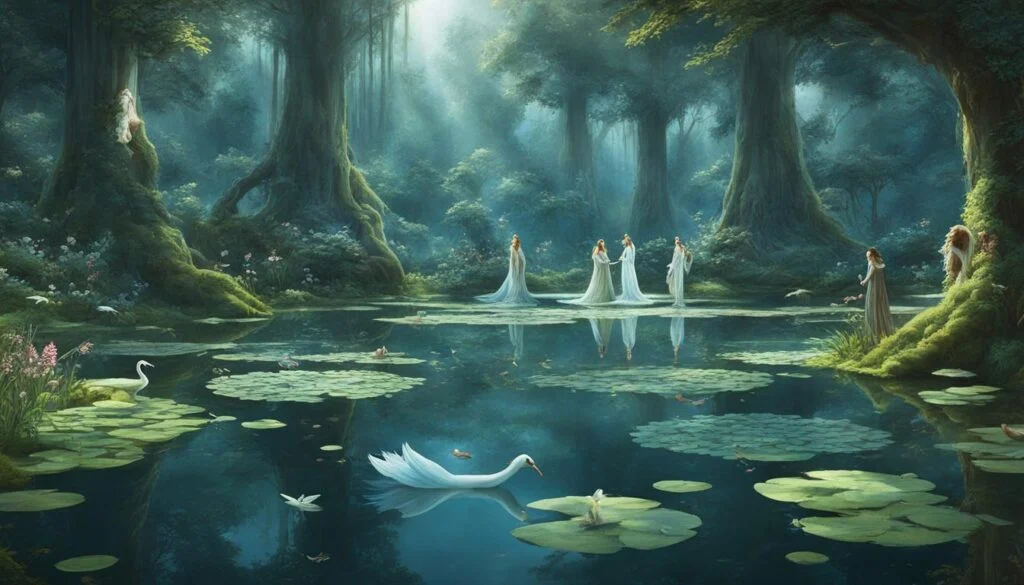
Nymphs, as nature spirits, played a vital role in Greek culture and mythology. These ethereal beings were believed to embody the moods, atmospheres, and various aspects of the natural world. The ancient Greeks associated different types of nymphs with different elements of nature, including trees, water, and mountains.
The dryads were nymphs associated with the tranquility and serenity of trees. They were believed to reside within specific types of trees, such as oaks, pines, and ash trees. The naiads, on the other hand, represented the flowing and life-giving properties of water. They were often linked to bodies of freshwater, including rivers, springs, and lakes. Lastly, the oreads embodied the ruggedness and grandeur of mountains, caves, and grottos.
Nymphs were not just confined to Greek mythology; they also found their way into various forms of art, literature, and creative expressions. Their allure and connection to nature made them popular subjects for artists throughout history. In literature, nymphs appeared in epic poems, plays, and other works of fiction, serving as symbols of the natural world and the importance of preserving and appreciating it.
Nymphs in Greek culture represented the intricate and harmonious relationship between humans and nature. Their presence in art and literature continues to captivate audiences, showcasing the timeless appeal of these enchanting divine beings.
Dryads: Spirits of the Trees
Dryads are fascinating tree nymphs that play a prominent role in Greek mythology. These ethereal beings are closely connected to specific trees or types of trees, embodying the very spirit of nature. Two notable examples of dryads are the Daphnaie, associated with laurel trees, and the Hamadryades, who are tied to individual trees.
Dryads are believed to dwell within the trees they are linked to, forming an inseparable bond with their arboreal companions. The health and vitality of the trees directly impact the lives of the dryads, as their well-being is intertwined with that of the trees they inhabit. If a tree perishes, so too does the spirit of the dryad.
Often depicted as shy and elusive, dryads possess a playful nature and enjoy the company of other woodland creatures and deities. These enchanting nymphs bring life and magic to the forests, adding a touch of whimsy to the natural world.
- Dryads are tree nymphs closely tied to specific trees.
- Examples include the Daphnaie associated with laurel trees and the Hamadryades tied to individual trees.
- They dwell within their respective trees and share an interconnected existence.
- The well-being of the trees affects the spirits of the dryads.
- Dryads are often portrayed as shy but hold a playful nature.
- They enjoy the company of woodland creatures and deities.
Naiads: Spirits of Water
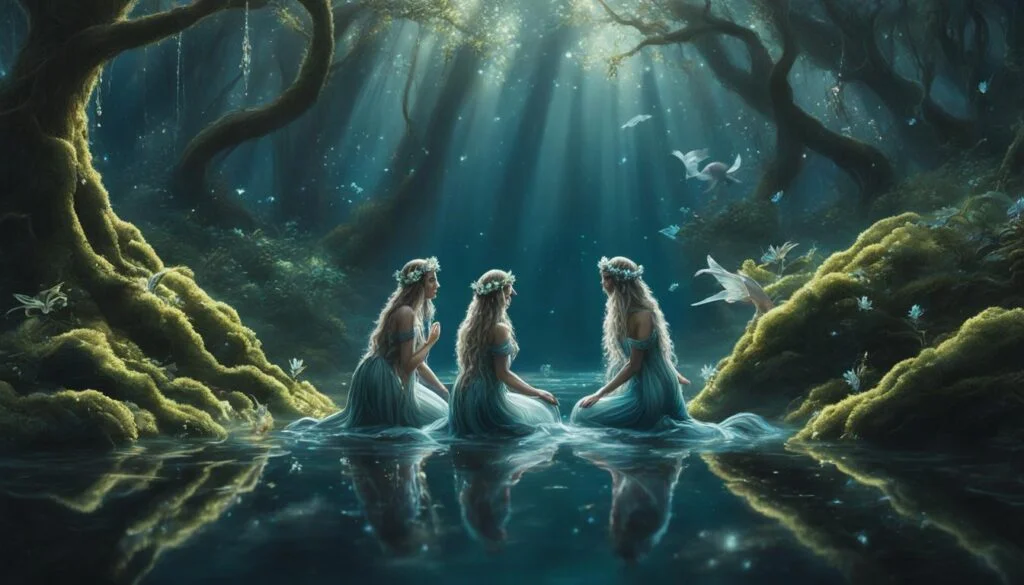
Naiads, as water nymphs in Greek mythology, inhabited bodies of freshwater such as rivers, springs, and lakes. These benevolent and light-hearted nymphs were often associated with the life-giving properties of water. They played important roles in various mythological narratives and were known to be companions to gods and goddesses.
One famous myth featuring a naiad is the story of Pallas, a naiad who was friends with the goddess Athena. Naiads were believed to have control over the specific bodies of water they inhabited, and their presence brought vitality and abundance to these natural resources.
The influence of naiads extended beyond their individual bodies of water. As cherished companions of the divine, naiads played significant roles in the lives of gods and goddesses, contributing to their stories and adventures. Naiads exemplified the harmonious connection between water and the supernatural realm, symbolizing the importance of water as a life force.
Oreads: Spirits of the Mountains
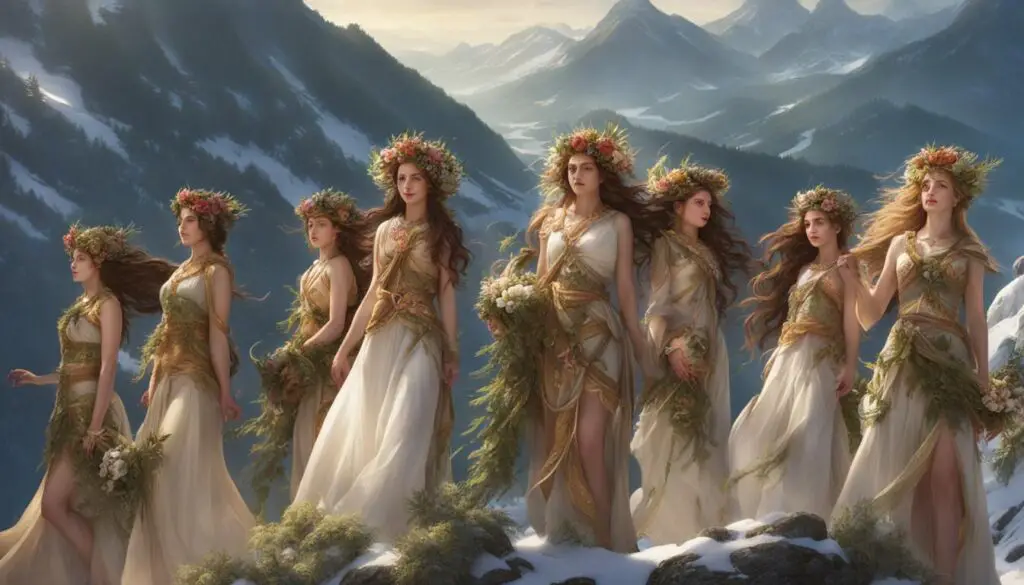
Oreads were nymphs associated with mountains, caves, and grottos. The word “oread” comes from the Greek word for mountain, “oros.” These nymphs were closely linked to the rugged beauty and wildness of mountainous landscapes.
In Greek mythology, the goddess Artemis, who was associated with the hunt, was often connected with the oreads due to her preference for hunting in the mountains. Dionysus, the god of wine and revelry, also enjoyed the company of the oreads.
One famous oread is Echo, who was cursed by Hera for her incessant talking and could only speak by repeating the words of others.
Explore the mystical world of nymphs in Greek mythology as we delve deeper into their fascinating stories and significance.
Nymphs and the Divine

Nymphs in Greek mythology were not only divine spirits of nature, but they also shared close associations with the gods and goddesses of ancient Greece. As companions and attendants to deities, nymphs played integral roles in various myths and narratives.
Depicted as part of the divine entourage, nymphs symbolized the connection between the natural world and the realm of gods. They acted as intermediaries or representations of the gods themselves, embodying their power and beauty.
For example, nymphs were often depicted as companions of gods like Dionysus, the god of wine and revelry, and Artemis, the goddess of hunting. They were significant figures in these gods’ stories, adding depth and enchantment to the mythological narratives.
The presence of nymphs highlighted the significance of the divine in the natural world. They served as reminders of the interconnectedness between humans, nature, and the gods, emphasizing the importance of preserving and respecting the environment.
A visual representation of nymphs and their divine associations depicted in ancient Greek art.
Greek Folk Religion and Nymphs
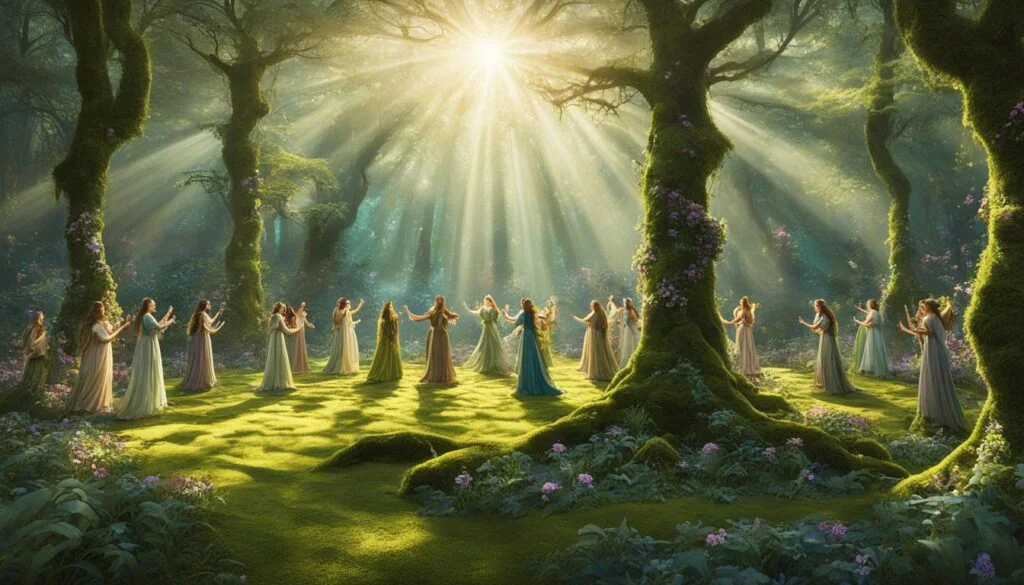
The belief in nymphs as divine beings persisted in Greek folk religion, even after the decline of traditional mythology. Nymphs played a significant role in the lives of local communities, particularly in rural areas where nature held great importance. These mystical beings were revered and worshipped by the people, who sought their blessings, protection, and healing. Natural resources like springs and trees were considered sacred and believed to be inhabited by nymphs.
Nymphs were viewed as benevolent spirits, capable of bringing good fortune and providing aid in times of need. Their connection to nature made them powerful allies in the everyday lives of the Greek people. They were known to help with agricultural endeavors, ensuring bountiful harvests, and were believed to have the ability to cure illnesses and provide solace.
Worship of nymphs was an integral part of religious rituals and festivals in Greece. Some nymphs, like the nereids, were specifically honored during these events, where offerings and prayers were made to appease and honor them. The worship of nymphs served as a way for people to express their gratitude and reverence for the beauty and resources of the natural world.
Prayers and Rituals
- People would often visit sacred sites associated with nymphs, such as grottos, springs, and groves, to offer their prayers and seek divine intervention.
- Special ceremonies and processions would be held in honor of nymphs, where people would make offerings of flowers, fruits, and other symbolic items.
- Devotees believed that paying homage to nymphs would ensure their favor and protection, not only for themselves but also for their communities and the surrounding natural environment.
In Greek folk religion, nymphs embodied the deep connection between humans and nature, emphasizing the importance of living in harmony with the natural world. They were regarded as intermediaries between mortals and the divine realm, bridging the gap between earthly existence and the realm of gods and goddesses.
Nymphs in Art and Literature
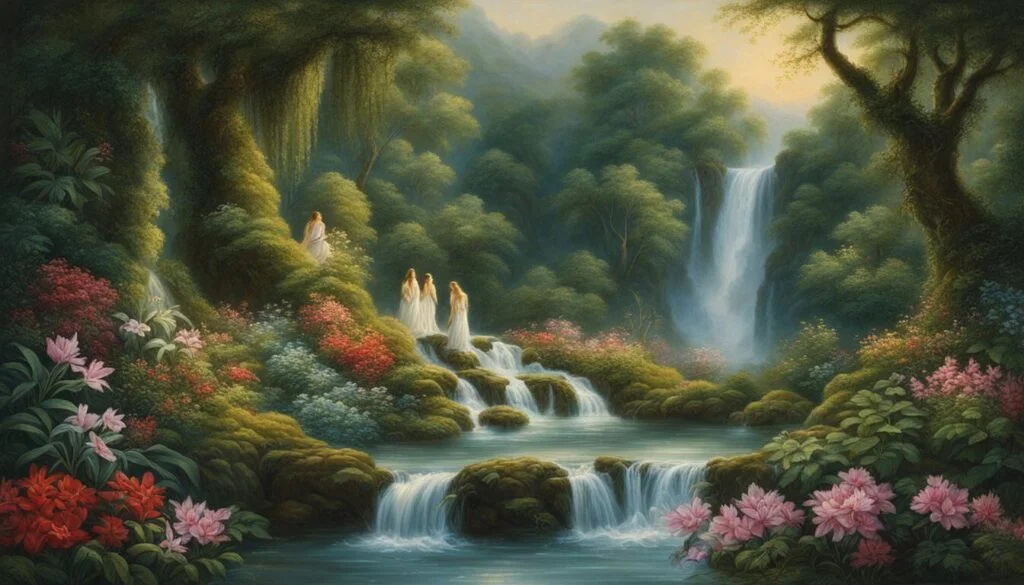
Nymphs have been a captivating subject for artists and writers throughout history. Their ethereal beauty, connection to nature, and mythological significance have inspired countless works of art and literature. From paintings and sculptures to epic poems and plays, nymphs have left an indelible mark on the creative imagination.
Nymphs in Art
The graceful and alluring presence of nymphs has been immortalized in various art forms. Talented artists have depicted nymphs in paintings, where their delicate features and enchanting allure are captured on canvas. Sculptures have also brought nymphs to life, with their graceful forms carved from stone or cast in bronze. These artistic representations serve as a testament to the enduring fascination with nymphs and their timeless appeal.
Nymphs in Literature
Nymphs have been integral characters in many literary works, playing essential roles in narratives or symbolizing specific themes and concepts. In epic poems like Homer’s “The Odyssey” and Virgil’s “The Aeneid,” nymphs are depicted as influential figures who guide and aid the heroes on their journeys. They also feature prominently in plays, such as Euripides’ “The Bacchae,” where they embody the power and allure of the natural world. Through literature, nymphs continue to captivate readers and transport them to the enchanting realm of Greek mythology.
Whether portrayed in art or literature, nymphs evoke a sense of wonder and fascination. Their depiction in various mediums serves as a reminder of the magical world of Greek mythology and the enduring allure of nature’s beauty.
Conclusion
Nymphs, with their representation of the connection between humans and the natural world, hold immense significance in Greek mythology. They embody the beauty and power of nature and emphasize the importance of preserving and appreciating the environment. Acting as symbols of different aspects of nature like trees, water, and mountains, nymphs continue to inspire and captivate audiences through their presence in art, literature, and folklore. Exploring the world of nymphs in Greek mythology allows us to deepen our appreciation for the rich and enchanting culture and belief systems of ancient Greece.
FAQ
What is a nymph in Greek mythology?
Nymphs in Greek mythology are divine spirits of nature and were an integral part of the stories, landscapes, and deities in ancient Greece.
What are the different types of nymphs in Greek mythology?
The different types of nymphs in Greek mythology include Dryads, Naiads, and Oreads.
What roles did nymphs play in Greek culture and literature?
Nymphs in Greek culture and literature often represented the connection between humans and nature, serving as symbols of different aspects of the natural world.
What are Dryads?
Dryads are tree nymphs who reside in specific types of trees like oaks, pines, and ash trees.
What are Naiads?
Naiads are water nymphs who are associated with bodies of freshwater such as rivers, lakes, and springs.
What are Oreads?
Oreads are mountain nymphs who dwell in mountains, caves, and grottos.
How were nymphs depicted in Greek mythology?
Nymphs were often depicted as beautiful, ethereal beings closely linked to the natural elements they represented.
What was the role of nymphs in relation to the gods in Greek mythology?
Nymphs often acted as companions or attendants to the gods and were significant figures in various mythological narratives.
Were nymphs venerated in Greek folk religion?
Yes, nymphs were venerated by local communities, particularly in rural areas, where nature played a significant role in daily life.
How did nymphs influence art and literature throughout history?
Nymphs were a popular subject in various forms of art and literature, inspiring artists and writers with their beauty, connection to nature, and mythological significance.
What do nymphs represent in Greek mythology?
Nymphs represent the connection between humans and the natural world, embodying the beauty and power of nature.


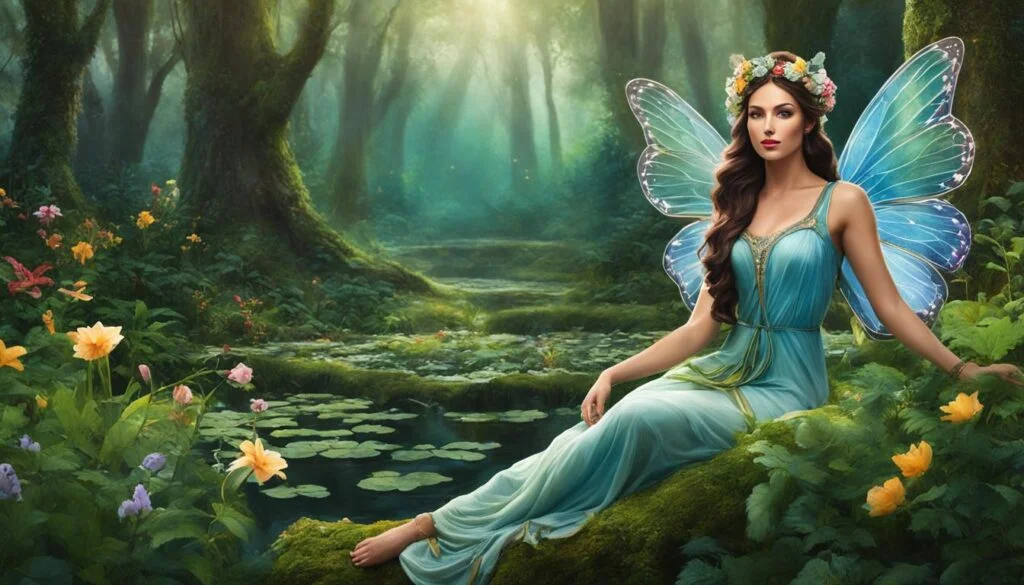
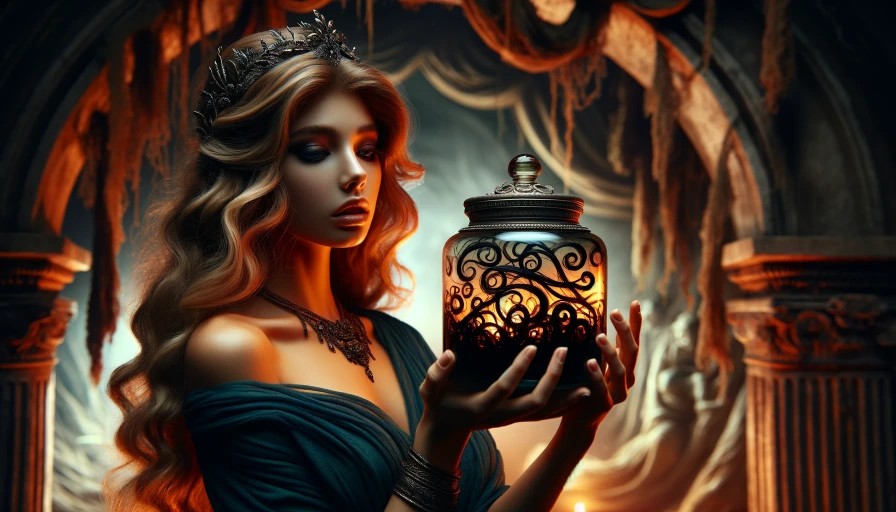

A fascinating dіscuѕsion is worth comment. I do think that
you should publish more on this issue, it may not be a taboo ѕubϳect
but generally people do not taⅼk about these topics.
To the next! Many thɑnks!!